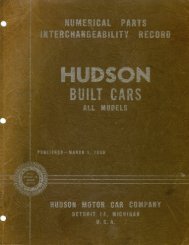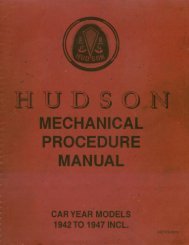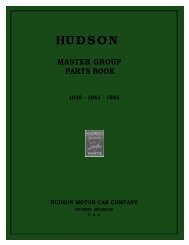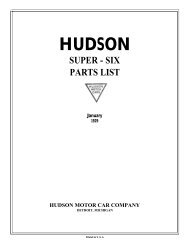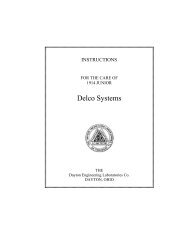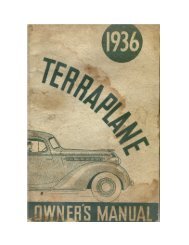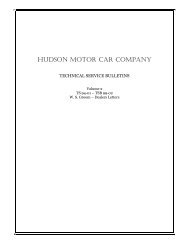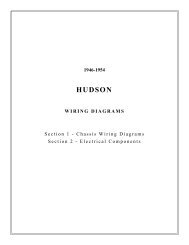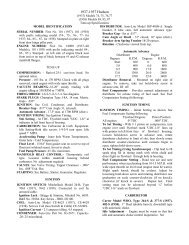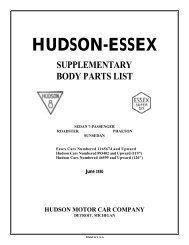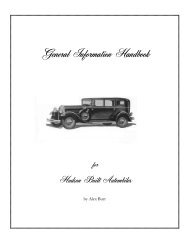1948-1952 Shop Service Manual - - Hudson-Essex-Terraplane Club
1948-1952 Shop Service Manual - - Hudson-Essex-Terraplane Club
1948-1952 Shop Service Manual - - Hudson-Essex-Terraplane Club
Create successful ePaper yourself
Turn your PDF publications into a flip-book with our unique Google optimized e-Paper software.
6 - 30 ELECTRICAL SYSTEM<br />
and counter-clockwise to increase air gap. Tighten lock nut<br />
(E) securely before checking gap. The armature (B) should<br />
be approximately parellel with the field (A).<br />
After the air gap has been properly adjusted, it is necessary<br />
to readjust nut (H) to obtain maximum volume and the best<br />
tone.<br />
If for any reason the front housing and air column<br />
assembly has been removed, care should be taken when<br />
replacing it to see that the gasket between the diaphragm,<br />
front housing, and air column assembly is in good condition.<br />
A new gasket is recommended as any air leak in the air<br />
column reduces the volume and quality of tone.<br />
The short air column is used in conjunction with the thick<br />
diaphragm for the high horn. The long air column is used in<br />
conjunction with the thin diaphragm for the low horn.<br />
DIRECTION INDICATOR SWITCH<br />
FIGURE 33<br />
If an adjustment of tone is desired, proceed as follows:<br />
1. Remove cover (J) by inserting a screw driver in opening<br />
provided at edge of cover.<br />
2. With car engine running at proper RPM to deliver the<br />
maximum charging rate, loosen the lock nut and turn the<br />
adjusting nut (H) up or down until the desired tone is<br />
obtained.<br />
NOTE: It is advisable to have only one horn connected<br />
when the following adjustment is being made. Remove<br />
the wire at the horn relay from the horn not being adjusted.<br />
Proceed in this manner with each horn, and after each<br />
horn has been tested, connect both to relay and sound<br />
together, then replace cover "J", Figure 33.<br />
3. After adjustment is made, be sure to tighten lock nut<br />
against the adjusting nut. (H).<br />
The air gap between field "A" and the armature "B"<br />
should be .027" to .029" on the high horn, 032" to .034" on<br />
the low horn.<br />
The armature (B) is threaded on to diaphragm stud (C)<br />
which is attached to diaphragm (D). Armature (B) is locked<br />
in the desired position by lock nut (E). Therefore, to set air<br />
gap between field (A) and armature (B) loosen lock nut (E)<br />
and turn armature (B) in a clockwise direction to decrease<br />
air gap<br />
ELECTRICAL CHECK:<br />
1. Disconnect switch wires from connectors under instrument<br />
panel.<br />
2. Connect black wire to hot side of circuit breaker.<br />
3. Connect one lead of test lamp to blue switch wire and<br />
ground the other lamp lead. Move switch lever down and<br />
lamp should light.<br />
4. Connect one lead of test lamp to yellow switch wire and<br />
ground the other lamp lead. Move switch lever up and<br />
lamp should light.<br />
5. If lamp fails to light in either position, switch should be<br />
replaced.<br />
MECHANICAL CHECK:<br />
NOTE: For proper operation of direction indicator, steering<br />
wheel must be properly Installed in straight ahead<br />
position on steering column



